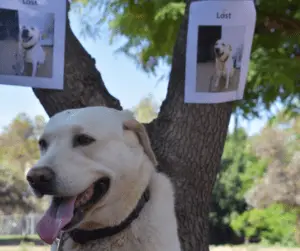What would you do if your dog or cat were missing? What if you found an animal? If you’re not sure, here are some ideas to help you out.
Table of Contents
ID First Defense
To better improve the chances that your pet will be returned to you if lost, be sure that he or she is wearing a collar and id tags. The identification could be a county license, a name tag or both.
It may be helpful to put a secondary phone number on the pet’s id, especially if you are away from home much of the time This could be your cell phone or work phone number, or the phone number of a willing relative, friend or even the animal’s veterinarian.
Check That Photo Album
Another thing that may come in handy would be a recent photograph. If you have a digital camera and a way to download photos to your computer, you can quickly make up “Lost Pet” flyers if you need them.
New Technology a Boon
Another form of identification is a microchip. This technology has been around for a number of years now, and has become more standardized.
A small radio-frequency chip, about the size of a grain of sand, is implanted just under the skin of the dog or cat. If you adopt an animal from a shelter, this will be done automatically, for others, you can take it to your vet to have one implanted.
In order for the implant to be meaningful, you must register the animal with the agency that provides the chip. The two primary makers are AVID, which is used by animal shelters, and Home-Again, which is the one used by veterinarians.
If you find an animal with no visible ID, you can take him or her to one of the vets in your area, or to an animal shelter. There they can “read” the chip using a special scanner, and locate the owner through the company’s database.
Start Close to Home
Of course you are keeping your cat inside, and your dog in a secure fenced area when outdoors, but escapes will happen.
If your pet does get away, the first thing you probably want to do is canvas the neighborhood. She might be safe in a neighbors yard, waiting for someone to come looking for her. Or someone may have seen a dog answering the description running down the street.
Have a leash with you, and treats if necessary to coax a playful dog to come to you.
Try the Shelters
If you don’t find him close to home, the next step would be to check the animal shelters. Some county and city codes require that anyone finding a stray animal must either turn it over to the local authorities or at least notify the agency, within twenty-four hours of finding the animal.
It then becomes your responsibility to go to the shelter and look for your pet. They usually will not tell you over the phone if your pet is there.
The shelter may be required to hold the animal for a set number of days, so it is best to check daily during this time. Space permitting, they will be held longer.
You will most likely have to pay a fee to redeem your animal, and to not redeem it may also be against the law and could result in a fine.
Flyers and Ads
If you do not find your pet at the shelter, then you might want post flyers and or place an ad in the local newspaper.
It is a good idea to withhold some identifying information when you do this. Then, when someone calls, you can use this bit of information to verify that they do indeed have your pet.
You may also like to read: Keeping Pets Cool, Dog Separation Anxiety – Reasons And How To Reduce It, Why Do Dogs Lick Paws
If you are a dog lover then, Subscribe to our weekly newsletters. No Spams!








